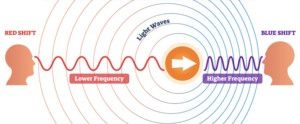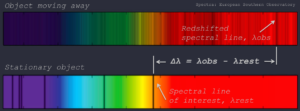The Colors are a Lie: The Doppler Effect and Redshift
Written by: Maneth Perera
At night, walk outside, take a breath of fresh air, and look up at the sky. The hundreds of tiny pinpricks of light and the many large flashes of white you see are all stars millions of miles away emitting light to your eyes. Yet, it’s almost impossible to differentiate between the different shades of white. However, with telescope imaging, we can take spectacular pictures of supernovae, nebulae, and stars bursting with color across the sky. They can zoom in thousands of times more than any telescope made for the human eye. But these vibrant colors are really lies. Lies which can ultimately tell us much more about the universe than we know now.
The Doppler Effect
All light comes in waves as disturbances in the electromagnetic field (these disturbances sometimes act as particles due to wave-particle duality, but in this case they are normal waves). The light emitted by stars is what receivers on Earth process to form images. What is crucial is the fact that light has a wavelength, frequency, and speed. The wavelength is the measurement from peak to peak and the frequency is the amount of waves that pass through a point in a second. The speed is how fast the wave travels through space. These 3 factors (mostly) define any given wave.
The main cause of the changes to our light perception is the Doppler Effect. Named after Christian Andreas Doppler, the Doppler Effect significantly affects the way waves are received. Imagine a receiver object and a source. The source emits waves periodically with a given wavelength, frequency, and speed. The receiver gets accurate information on each wave it receives. Now imagine what happens when the source starts moving. When it moves away from the receiver, each new wave emitted has to travel farther and farther. This ends up increasing the wavelength and decreasing the frequency of the waves the receiver gets. The waves emitted stay the same, but what the receiver gets changes. When the source moves towards the receiver, the waves get bunched up with each other as they catch up to one another. This causes a shorter wavelength but a higher frequency. The speed at which the waves travel stays the same.
Figure 1

Here, the Doppler Effect is shown for one source and two receivers. As the source moves between them, the frequency that each receiver gets varies.
Source: AudioCardio
Redshift and Blueshift
The Doppler Effect massively influences how we perceive moving celestial objects in space. When we observe galaxies moving away from us, they appear to be red-tinted. This is because of how the visible light spectrum works. The redder end of the spectrum has a longer wavelength while the more purple/bluish end of the spectrum has a shorter wavelength. Therefore, when the wavelength is observed to be longer than it is, the visible light’s color is shifted to be more red. This phenomenon is called redshift. When the wavelength is observed to be shorter, the visible light’s color is shifted to be more blue. This is called blueshift.
Almost all of the galaxies we have observed have a redshift. This indicates that they’re moving away from us. This result is extremely significant as we can determine how the universe is changing from how fast or slow the galaxies move. Since most galaxies are moving away, we can predict that the universe is expanding- but at what rate? When we observe redshift, we can calculate the original wavelength by determining how fast the source is moving and therefore how much the wavelength should have changed. A higher redshift value means the galaxy is moving faster and a lower value means it’s moving slower.
By analyzing how galaxies moved, scientists found out that galaxies farther than us moved away faster. Think of a balloon with dots drawn on it expanding at an exponential rate. Those dots would move away from each other faster and faster as the balloon got bigger and bigger. Similarly, the universe’s growth was determined to actually be speeding up instead of staying at a constant rate or slowing down.
This idea led the way to many new theories and hypotheses about how our universe formed such as Hubble’s Law, the Big Bang Theory, and others. It also allowed us to pursue more research into galaxy formation, dark matter, dark energy, and the movement of star systems. The age and size of the universe has massive impacts on the matter within it, and the way it changes celestial objects can affect much of our research down here on Earth.
Figure 2

The change in wavelength (represented by a delta symbol for change and a lambda symbol for wavelength) is shown to be equal to the observed wavelength minus the actual wavelength when the source is at rest. It shifts through the visible light spectrum shown above.
Source: University of Iowa, Physics and Astronomy Department; European Southern Observatory
Conclusion
The colors of our universe are truly an enigma. Even with sophisticated technology and the ability to calculate many different aspects of our universe, we are still learning more every day. The Doppler Effect, the resulting redshift and blueshift, and other factors all influence the way we perceive the universe whilst telling us a lot more than we could have known without them. Every day, new theorems predicting the expansion of the universe and new calculations with increasing precision and accuracy for the universe’s age are found. As technology develops, new advances in aerospace and physics will hopefully allow us to unlock more secrets about the night sky above us.
References and Sources
European Space Agency. (2001, October 24). What is “Red Shift”? ESA. https://www.esa.int/Science_Exploration/Space_Science/What_is_red_shift
Physics and Astronomy Department. (2021, August). Astronomical Redshift. Imaging the Universe – The University of Iowa. https://itu.physics.uiowa.edu/labs/advanced/astronomical-redshift
Berman, B. (2023, September 6). Strange Universe: Space Colors. Strange Universe: Space colors. https://www.astronomy.com/science/strange-universe-space-colors/
AudioCardio. (2020, November 16). The Doppler Effect and How it Affects Our Hearing. https://audiocardio.com/hearing-loss/the-doppler-effect-and-how-it-affects-our-hearing/
3 thoughts on “The Colors are a Lie: The Doppler Effect and Redshift”